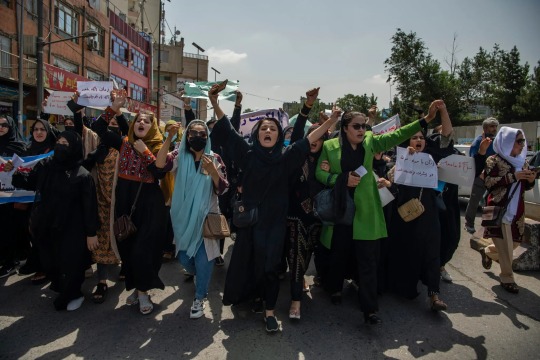#kiana hayeri
Photo


Hafiza makes bread in preparation for a family gathering.
KIANA HAYERI
1K notes
·
View notes
Text
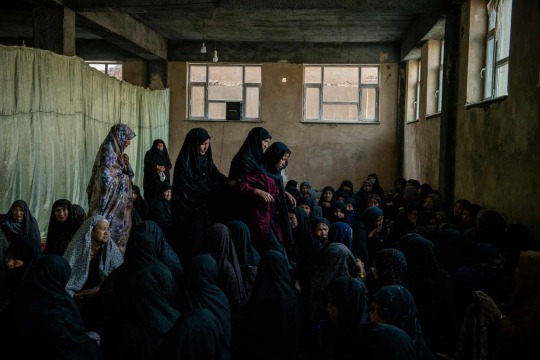
In May 2021, an explosion outside a high school in Kabul, Afghanistan, killed at least 70 people and wounded more than 150, many of them teenage girls leaving class. Visual storyteller Kiana Hayeri took this photograph in the basement of an unfinished mosque where neighbours and relatives of two of the victims have gathered to support their mothers through their grief
Photograph: Kiana Hayeri
1 note
·
View note
Text
Spring Cleaning Has Ancient Origins. Here’s Why We Still Do It.
While the specific customs and practices may vary across cultures, the underlying themes of purification, preparation for new beginnings, and the celebration of spring’s arrival remain central to this enduring tradition.
— By Lola Méndez | March 19, 2024

A man washes a rug the day before Nowruz or the Persian New Year, near Kohna Deh village in Afghanistan. Known as khāne-takānī, this spring-cleaning ritual keeps evil away, so people can bring fresh, new energy into their new year. Photograph By Kiana Hayeri, National Geographic Image Collection
As the Northern Hemisphere ushers in the new season, a contagious urge to dust off cobwebs and toss out clutter emerges. Spring cleaning, a deep cleanse of one’s home, is a tradition ingrained in societies worldwide, with roots tracing back to ancient times.
It also holds symbolic significance. Viewed as a fresh start, the tradition symbolizes the transition from the dormant winter season to the vibrant growth of spring. By purging the home of accumulated debris and organizing its contents, individuals create a cleaner living environment and a sense of mental clarity and freshness.
“With each sweep of the broom and polish of the surface, we honor a tradition that transcends time, uniting us with generations past in a shared pursuit of renewal and rejuvenation,” says Danielle Patten, director of creative programs and collections at the Museum of the Home in London.
Benefits of Spring Cleaning
Human behavior is greatly influenced by the cycles of nature. In the colder months, we have less energy to spare for chores such as deep cleaning. We’re not being lazy; limited daylight triggers the hormone melatonin, which makes us sleepy.
“Melatonin causes us to feel less inclined to refresh our space. When the seasons start to shift, feelings of sluggishness reduce, and we regain energy and feel inspired to deep clean our living environments,” says author and psychotherapist Eloise Skinner. “When we refresh our environments, we can feel a sense of new beginning, or a renewed sense of drive and ambition.”
Studies have also shown that cleaning can be therapeutic, as seen by the new generation of “cleanfluencers” taking social media by storm. Millions of people watch them scour filthy homes and dole out cleaning hacks.
“When we’re cleaning, we often have to be present to the task at hand, and this can bring us into the present moment causing us to feel more aware, engaged and observant. The repetitive nature can also be soothing,” Skinner says.
Religious and Cultural Origins
One of the earliest known references to spring cleaning is found in the Jewish tradition of Passover, which is observed annually in March or April. People remove all traces of chametz or leavened bread, which is prohibited leading up to the holiday. Its removal symbolizes the haste with which the Israelites fled Egypt, unable to wait for their bread to rise before their journey to freedom.
Similarly, Catholics clean altars in churches on Maundy Thursday ahead of Good Friday, which is held annually in the spring in March or April. Nowruz, celebrated around the vernal equinox in March, involves the tradition called khāne-takānī or “shaking down the house.” People wash clothes, blankets, and textiles in preparation for this approximately 3,000-year-old holiday—which can be traced back to Zoroastrianism, one of the world’s first monotheistic religions.
Before the Lunar New Year, it’s common to cleanse the home of bad luck and misfortune in China. Known as “sweeping the dust,” cleaning makes way for the new year’s good luck and prosperity, says Patten. Cleaning must be done before the holiday, typically in January or February, since sweeping after the festivities is seen as removing good luck. In Thailand, during Songkran in April, it’s customary to deep clean homes, schools, and public spaces to purify them ahead of the Thai New Year. People toss water at each other in the streets to wash away the previous year’s bad luck and over statues of Buddha to ensure luck for the year to come.
While the concept of spring cleaning predates modern technology, advancements such as electricity and household appliances have influenced its practice. For example, before electric lights, people relied on fire from burning coal, oil, and wood to light and heat homes, which would leave behind a substantial amount of soot. Windows were kept securely closed to prevent a deadly draft from entering.
Come spring, it was pragmatic to open the windows to air out stuffy homes, remove grime, and repair any damages that occurred during the winter months. Inventions such as vacuum cleaners, washing machines, and cleaning agents have made the process more efficient and convenient, allowing for deeper and more thorough cleaning of living spaces.
1 note
·
View note
Text
⏺ The Everyday Projects 2023 Grant
Deadline 08.05.2023 :: Anywhere
The Everyday Projects is awarding two grants to photographers for long-term projects in their own community. The selected applicants will receive $6,000 each and mentorship from Kiana Hayeri and Jennifer Samuel.
Priority will be given to photographers who have contributed to The Everyday Projects or the African Photojournalism Database and whose projects align with the organisation's mission of promoting human dignity and defying stereotypical imagery.
Application details here.
0 notes
Text
How Campus Ministry and Social Action is Addressing Climate Change and Immigration
By Julian Tiburcio
Conor Reidy, who works as the campus minister in Campus Ministry and Social Action (CMSA), met with me at CMSA’s Community Engagement Fair on Wednesday to discuss Manhattan College’s work on climate change and its impact on refugees.
“Obviously, social justice is such an important part of our Lasallian heritage,” he said. “You know, we have these five points on the Lasallian star, which is the star you can see on all of our insignias, and one of the five points is concerned with the poor and social justice. So it’s really so central a tenant to what we think is important for our school and for what we want to teach our students.”
Reidy believes that educating students about current events is essential for an institution to produce well-rounded students.
“We try to do these things where we, like, focus on justice issues that are big in the news right now, but also happen to be very close to our identity as a Catholic Lasallian school,” he said.
One particular cause that CMSA will be exploring throughout this semester is refugee advocacy, a topic that has strong ties to climate change and its effects on people.
Reidy explained that this topic is closely connected to the World Day of Migrants and Refugees, which falls on the last Sunday of September. The Catholic Church created this day in 1914 as a way to focus its attention on those who are most in need around the world due to their refugee status.
Conor Reidy shared some insight into immigration and displacement caused by climate change. He specifically commented on the current climate issues in Pakistan and how the country is currently submerged underwater.

Boats in Johi, Pakistan waiting to transport fuel, food, motorbikes and livestock between flooded villages. (KIANA HAYERI / NEW YORK TIMES)
“Trying to comprehend what that means for folks when they’re just trying to eat, gather water, educate their children, and not die of dengue or malaria, which become so prevalent when you have standing water; it’s really difficult to understand what that means,” he said.
Reidy says that exercising empathy and making an effort to understand what people displaced by climate change are going through is an essential step to help communities that are recovering from these issues.
“I think what we as a community and as a country need to discuss is what responsibilities we have as a country that, you know, has caused 20% of climate change to be occurring…,” Reidy said.
While these climate issues in Pakistan might be taking place across the world, CMSA tries to make a difference locally, organizing programs that educate students and enable them to help disadvantaged people, including immigrants, more directly.

Manhattan College students involved in a LOVE trip. (MANHATTAN COLLEGE / COURTSEY)
Doriz Yari, a senior who has participated in the LOVE program, told me about how she’s developed a better understanding of immigration issues in a more hands-on way through the program. Through her trips to El Paso, Texas, she’s been able to experience these social issues more closely and learn about the struggles that immigrants endure.
“There’s a lot that you can learn from the internet, from a textbook, but it doesn’t really compare to being there in-person and talking to people firsthand,” Yari said.
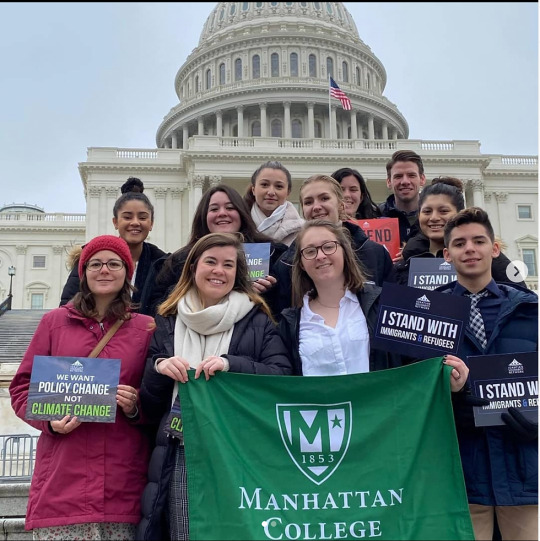
Manhattan College students advocated for change on Capitol Hill in 2019. (CONOR REIDY / COURTSEY)
Student engagement is a crucial part of the success of all of these programs and for creating change on campus, Yari shared.
All of this work relating to climate change and immigration is only part of what CMSA does, so Reidy encourages students to identify social injustices themselves, and to work proactively against them as a community.
“I would also say if people have a special interest in other areas [of social justice,] we are always open and welcome to talking more about that,” said Reidy.
Originally published at https://jtiburcio01.wixsite.com on September 15, 2022.
1 note
·
View note
Text
Die Preisträger*innen des Leica Oskar Barnack Preises
Die Preisträger*innen des Leica Oskar Barnack Preises
Die Preisträger*innen des Leica Oskar Barnack Preises
Hunderte von Frauen in ihren besten Kleidern und mit Make-up bei der Nowruz-Feier im Dorf Nalij im Bezirk Miramor in Daikundi, 21. März 2021. Nach der Machtübernahme der Taliban wurden die Nouruz-Feierlichkeiten im ganzen Land abgesagt © Kiana Hayeri
Annika Schönfeldt
Mi., 30.11.2022 – 13:22
Auch 2022 präsentiert das Ernst Leitz Museum die…

View On WordPress
0 notes
Text
‘We Have Nothing:’ Afghan Quake Survivors Despair Over Recovery
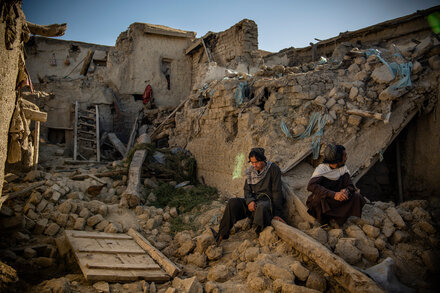
By BY CHRISTINA GOLDBAUM, SAFIULLAH PADSHAH AND KIANA HAYERI
With the economy in ruins and aid in short supply, survivors of the earthquake in this remote stretch of eastern Afghanistan wonder what their next move could be.
Published: June 25, 2022 at 11:02AM
from NYT World https://ift.tt/I0bpYoC
via IFTTT
0 notes
Photo

"The Taliban Pressure Women in Afghanistan to Cover Up" by BY DAVID ZUCCHINO, YAQOOB AKBARY AND KIANA HAYERI via NYT World https://ift.tt/7PjLIkB
0 notes
Text

Afghanistan
Kiana Hayeri
26 notes
·
View notes
Photo
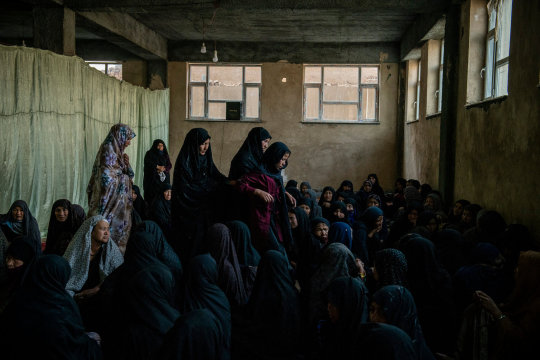
Kabul, Afghanistan, May 9.
4 notes
·
View notes
Photo

What Will Become of Afghanistan’s Post-9/11 Generation?
Kiana Hayeri for The New York Times
3 notes
·
View notes
Photo
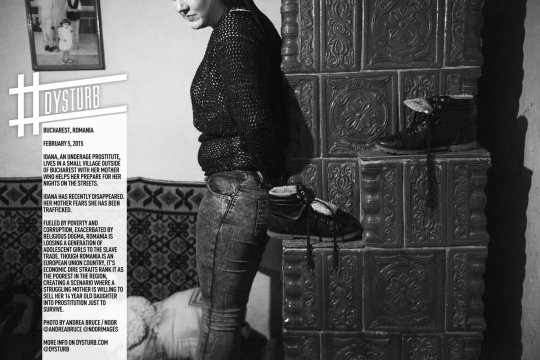



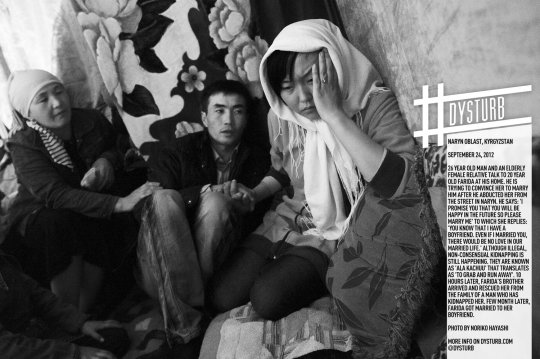
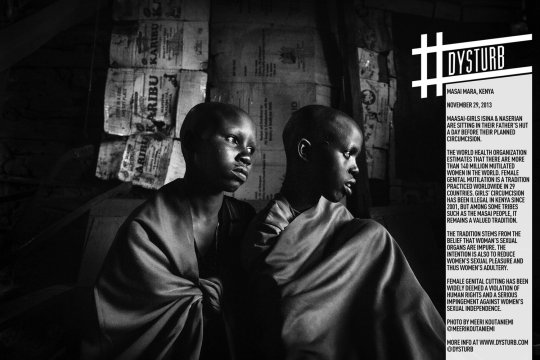




Dysturb #womenmatter
Photojournalism is a universal language with the power to demolish stereotypes, trigger discussions and alert consciences.
In 2014 Dysturb began pasting mural-sized guerrilla blow ups in public places: city walls, skate parks, and school hallways. In stark black and white, they make billboard sized prints of news images from photojournalists around the world, on a scale usually only seen in color commercial advertisements, to bring crucial subjects - like climate change, women’s issues, refugee crisis - and place them directly in front of people’s eyes.
#bnw#street#dysturb#womenmatter#andrea bruce#glenna gordon#poulomi basu#ilona szwarc#noriko hayashi#meeri koutaniemi#leonora baumann#krisanne johnson#kiana hayeri#pep bonet#headscarf
3 notes
·
View notes
Text
In Afghan Quake: ‘I Did Not Expect to Survive’

By BY CHRISTINA GOLDBAUM, SAFIULLAH PADSHAH, KYLE CRICHTON AND KIANA HAYERI
As aid workers and volunteers rushed to help, survivors told harrowing tales of death and destruction.
Published: June 23, 2022 at 05:23PM
from NYT World https://ift.tt/vf7cK2B
via IFTTT
0 notes
